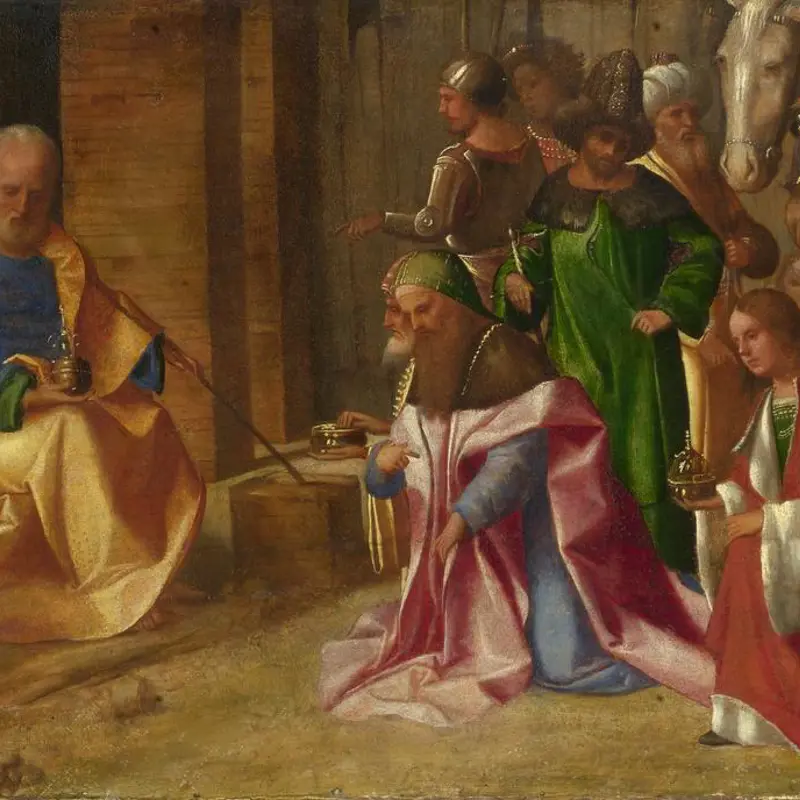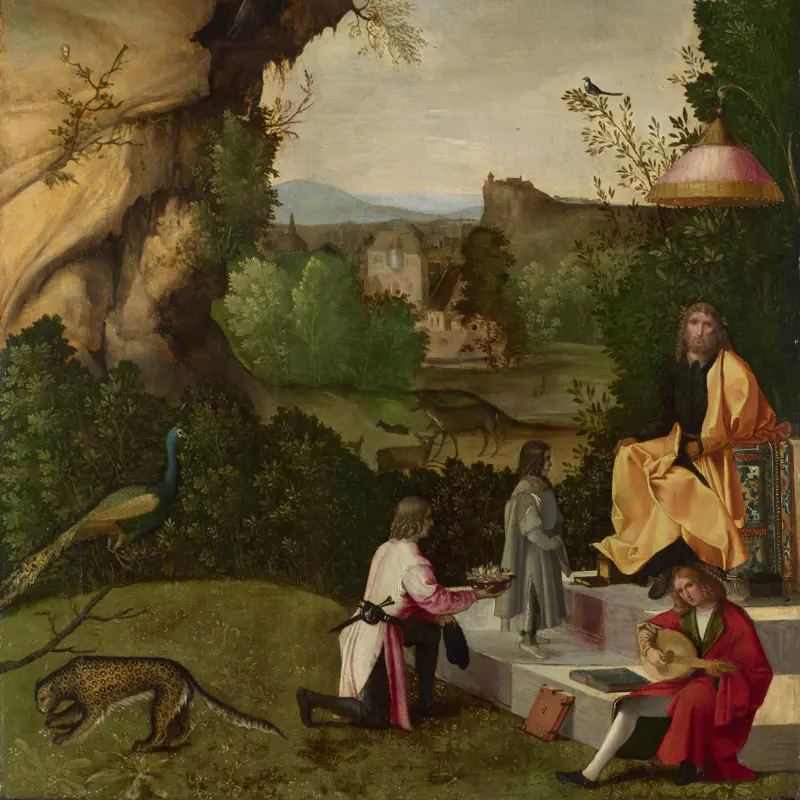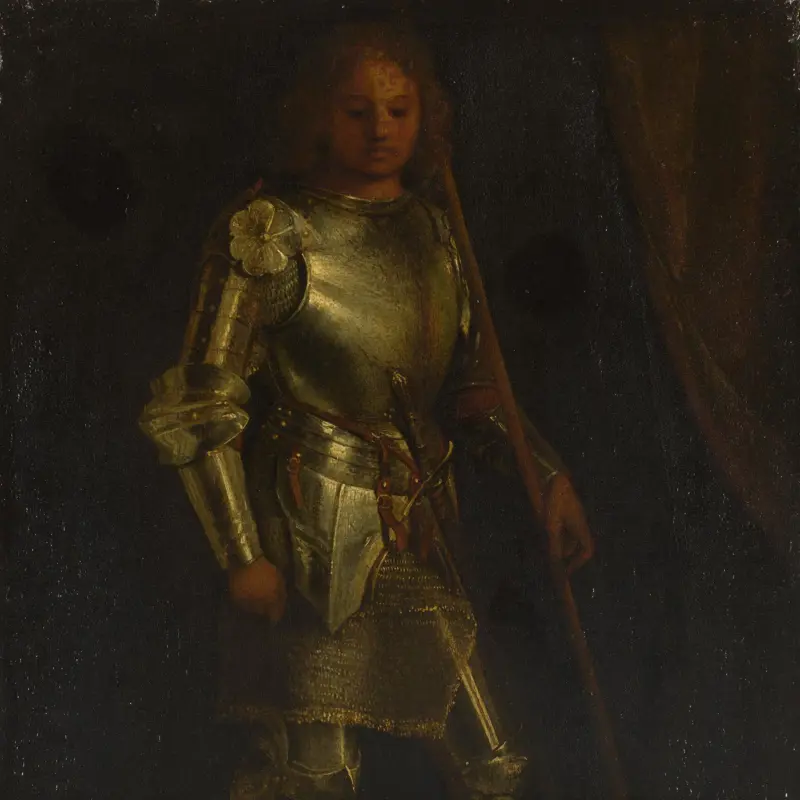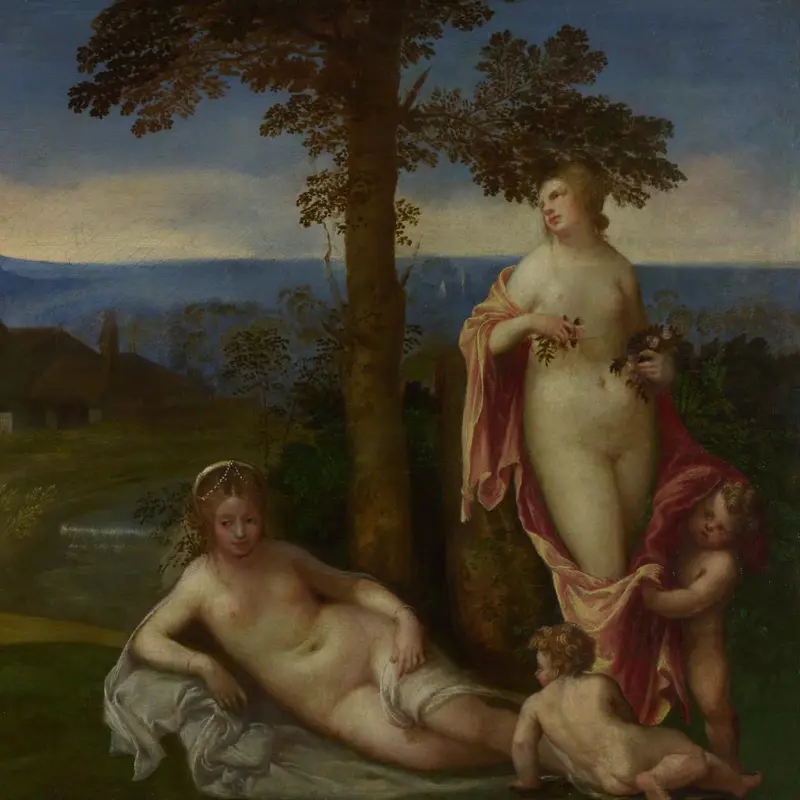Giorgione, 'Il Tramonto (The Sunset)', 1506-10
About the work
Overview
The meaning of this scene is difficult to decipher, largely because the painting is very damaged and many areas are not original. The two foreground figures are genuine and may represent Saint Roch and Gothardus, who tended the plague sore on Saint Roch’s thigh. If this is the case, the picture might have been painted to commemorate relief from the plague in the Veneto in 1504. The sinister little beaked creature emerging from the water also seems to be genuine, although its meaning is unclear.
After its rediscovery in the 1930s, the painting underwent several phases of restoration. Saint George and the dragon were added to cover a large area of damage, as was the monster in the lake, and the ‘hermit’ in the cave on the right was extensively repainted. However, the distant landscape with its atmospheric dissolution of light is evidence of Giorgione’s work.
Key facts
Details
Provenance
Additional information
Text extracted from the ‘Provenance’ section of the catalogue entry in Cecil Gould, ‘National Gallery Catalogues: The Sixteenth Century Italian Schools’, London 1987; for further information, see the full catalogue entry.
Exhibition history
-
2009GiorgioneMuseo Casa di Giorgione12 December 2009 - 11 April 2010
-
2010Close Examination: Fakes, Mistakes and DiscoveriesThe National Gallery (London)30 June 2010 - 12 September 2010
-
2012Titian's First Masterpiece: The Flight Into EgyptThe National Gallery (London)4 April 2012 - 19 August 2012
-
2012Il Tiziano mai visto: La fuga in Egitto e la grande pittura venetaGallerie dell'Accademia (Venice)29 August 2012 - 9 December 2012
-
2016In the Age of GiorgioneRoyal Academy of Arts12 March 2016 - 5 June 2016
Bibliography
-
1933G. Sangiorgi, 'Scoperta di un'opera di Giorgione', Rassegna italiana, XXXIV/186, 1933, pp. 789-93
-
1933T.S., 'Documenti: Ancora della scoperta di un'opera del Giorgione', Rassegna italiana, XXXIV/187, 1933, pp. 898-9
-
1934R. Longhi, Officina ferrarese, Rome 1934
-
1934G. Lorenzetti, La collezione dei conti Donà dalle Rose a Venezia, Venice 1934
-
1934G. Fiocco, 'Review: L. Hourticq, "Le problème de Giorgione", A. Ferriguto, "Attraverso i misteri di Giorgione", and F. Hermanin, "Il mito di Giorgione"', Pan, XII, 1934, pp. 787-8
-
1937G.M. Richter, Giorgio da Castelfranco, Called Giorgione, Chicago 1937
-
1941G. Fiocco, Giorgione, Bergamo 1941
-
1942A. Morassi, Giorgione, Milan 1942
-
1944R. Pallucchini, La pittura veneziana del Cinquecento, Novara 1944
-
1954C. Gamba, 'Il mio Giorgione', Arte veneta, VIII, 1954, pp. 172-7
-
1955P. Della Pergola, Giorgione, Milan 1955
-
1955L. Coletti, 'Un tema giorgionesco', Emporium, LXI/121, 1955, pp. 195-208
-
1955G. Fiocco, 'Il mio Giorgione', Rivista di Venezia, I/1, 1955, pp. 5-22
-
1955P. Zampetti, 'Postille alla mostra di Giorgione', Arte veneta, IX, 1955, pp. 54-70
-
1955P. Zampetti, Giorgione e i Giorgioneschi (exh. cat. Palazzo Ducale (Venice), 11 June - 23 October 1955), Venice 1955
-
1956L. Düssler, 'Die Giorgione-Ausstellung in Venedig', Kunstchronik, IX/1, 1956, pp. 1-5
-
1961P. Hendy, 'Taste and Science in the Presentation of Damaged Pictures', in I.E. Rubin (ed.), Acts of the Twentieth International Congress of the History of Art: 7-12 September, New York, 1961, New York 1961, pp. 139-45
-
1962The National Gallery, The National Gallery: January 1960 - May 1962, London 1962
-
1964M. Bonicatti, Aspetti dell'umanesimo nella pittura veneta dal 1455 al 1515, Rome 1964
-
1968V. Lilli and P. Zampetti, L'opera completa di Giorgione, Milan 1968
-
1969T. Pignatti, L'opera completa di Giovanni Bellini, Milan 1969
-
1973J. Fletcher, 'Marcantonio Michiel's Collection', Journal of the Warburg and Courtauld Institutes, XXXVI, 1973, pp. 382-5
-
1975C. Gould, Delaroche and Gautier: Gautier's Views on the 'Execution of Lady Jane Grey' and on other Compositions by Delaroche, London 1975
-
1978R. Longhi, Ricerche sulla pittura veneta: 1946-1969, Florence 1978
-
1979C. Gould, 'Giorgionesque Problems in the National Gallery (with some Reference to Craquelure)', in F. Pedrocco (ed.), Giorgione; atti del Convegno internazionale di studio per il 5˚ centenario della nascita, 29-31 maggio 1978, Castelfranco Veneto 1979, pp. 253-5
-
1981A. Gentili, 'Per la demitizzazione di Giorgione: Documenti, ipotesi, provocazioni', in M. Calvesi (ed.), Giorgione e la cultura veneta tra '400 e '500: Mito, allegoria, analisi iconologica, Rome 1981, pp. 12-25
-
1984J. Hoffman, 'Giorgione's "Three Ages of Man"', Pantheon, XLIII/3, 1984, pp. 238-44
-
1987Gould, Cecil, National Gallery Catalogues: The Sixteenth Century Italian Schools, London 1987
-
1992A. Enderle, Kleine Menschen - große Kunst. Kleinwuchs aus künstlerischer und medizinischer Sicht, Hamm 1992
-
1992C. Hornig, 'Giorgione - oder nicht?: Mit einem Verzeichnis der abzuschreibenden Gemälde', Pantheon, L, 1992, pp. 46-54
-
1992W.R. Rearick, 'From Arcadia to the Barnyard', Studies in the History of Art, XXXVI, 1992, pp. 136-59
-
1993A.P. Torrini, Giorgione: Catalogo completo dei dipinti, Florence 1993
-
1993J. Martin, 'Giorgione e Baldassar Castiglione. Proposte per l'interpretazione di un passo fondamentale del "Cortegiano"', Venezia cinquecento, III/5, 1993, pp. 57-66
-
1993M. Laclotte (ed.), Le siècle de Titien: L'âge d'or de la peinture à Venise (exh. cat. Galeries Nationales du Grand Palais, 9 March - 14 June 1993), Paris 1993
-
1993A. Gentili, 'Giorgione non finito, finito, indefinito', in R. Varese (ed.), Studi per Pietro Zampetti, Ancona 1993, pp. 288-99
-
1995E. Guidoni, Studi su Giorgione e sulla pittura del suo tempo: Conferenze 1995-96, 5 vols, Rome 1995
-
1995M. Lucco, Giorgione, Milan 1995
-
1995M. Giebe, 'Die "Schlummernde Venus" von Giorgione und Tizian: Bestandsaufnahme und Konservierung: Neue Ergebnisse der Röntgenanalyse', Beiträge und Berichte der Staatlichen Kunstsammlungen Dresden, XXIII, 1995, pp. 93-110
-
1996H. Anderson, Giorgione, peintre de la 'brièveté poétique'. Catalogue raisonné, Paris 1996
-
1998E. Guidoni, 'Le rocca nella pittura di Giorgione', Studi giorgioneschi: Annuario di ricerche sull'arte del Rinascimento, II, 1998, pp. 6-10
-
1999E. Guidoni, Giorgione: Opere e significati, Rome 1999
-
1999T. Pignatti, Giorgione, New York 1999
-
1999G. Helke, 'Giorgione als Maler des Paragone', Jahrbuch des Kunsthistorischen Museums Wien, I, 1999, pp. 11-79
-
2001
C. Baker and T. Henry, The National Gallery: Complete Illustrated Catalogue, London 2001
-
2001W.R. Rearick, Il disegno veneziano del Cinquecento, Milan 2001
-
2002C. Eisler, 'La "Tempesta" di Giorgione: Il primo "capriccio" della pittura veneziana', Arte veneta, LIX, 2002, pp. 84-97
-
2004L. Trezzani (ed.), La pittura di Paesaggio in Italia: Il Seicento, Milan 2004
-
2006D.A. Brown et al., Bellini, Giorgione, Titian and the Renaissance of Venetian Painting (exh. cat. National Gallery of Art, Washington, 18 June - 17 September 2006; Kunsthistorisches Museum, 17 October 2006 - 7 January 2007), New Haven 2006
-
2007W. Eller, Giorgione: Catalogue Raisonné: Mystery Unveiled, Petersberg 2007
-
2008M. Calvesi, 'Più novità su Giorgioe e un soggetto per Battista Dossi', Storia dell'arte, XXI/121, 2008, pp. 5-24
-
2009E.M. Dal Pozzolo and L. Puppi (eds.), Giorgione (exh. cat., Museo Casa Giorgione, Castelfranco Veneto), Milan 2009
-
2009C. Falciani, '"La Tempesta" di Giorgione e un poemetto encomiastico dedicato ai Vendramin', Studiolo, 7, 2009, pp. 101-23
-
2009E.M.D. Pozzolo et al., Giorgione (exh. cat. Museo Casa Giorgione, 12 December 2009 - 11 April 2010), Milan 2009
-
2010E. Greer and N. Penny, 'Giorgione at the National Gallery', The Burlington Magazine, CLII/1287, 2010, pp. 364-75
About this record
If you know more about this work or have spotted an error, please contact us. Please note that exhibition histories are listed from 2009 onwards. Bibliographies may not be complete; more comprehensive information is available in the National Gallery Library.




